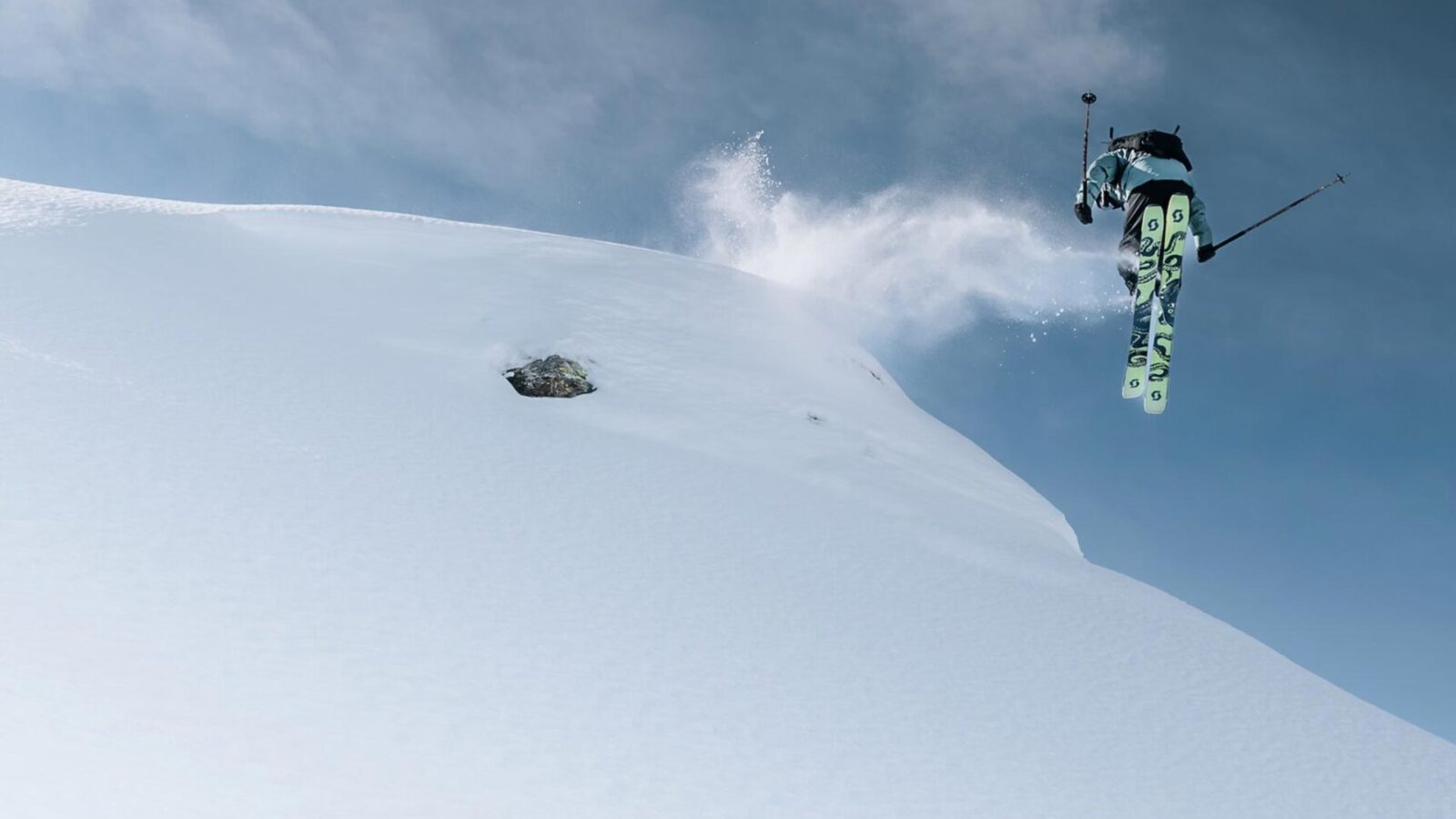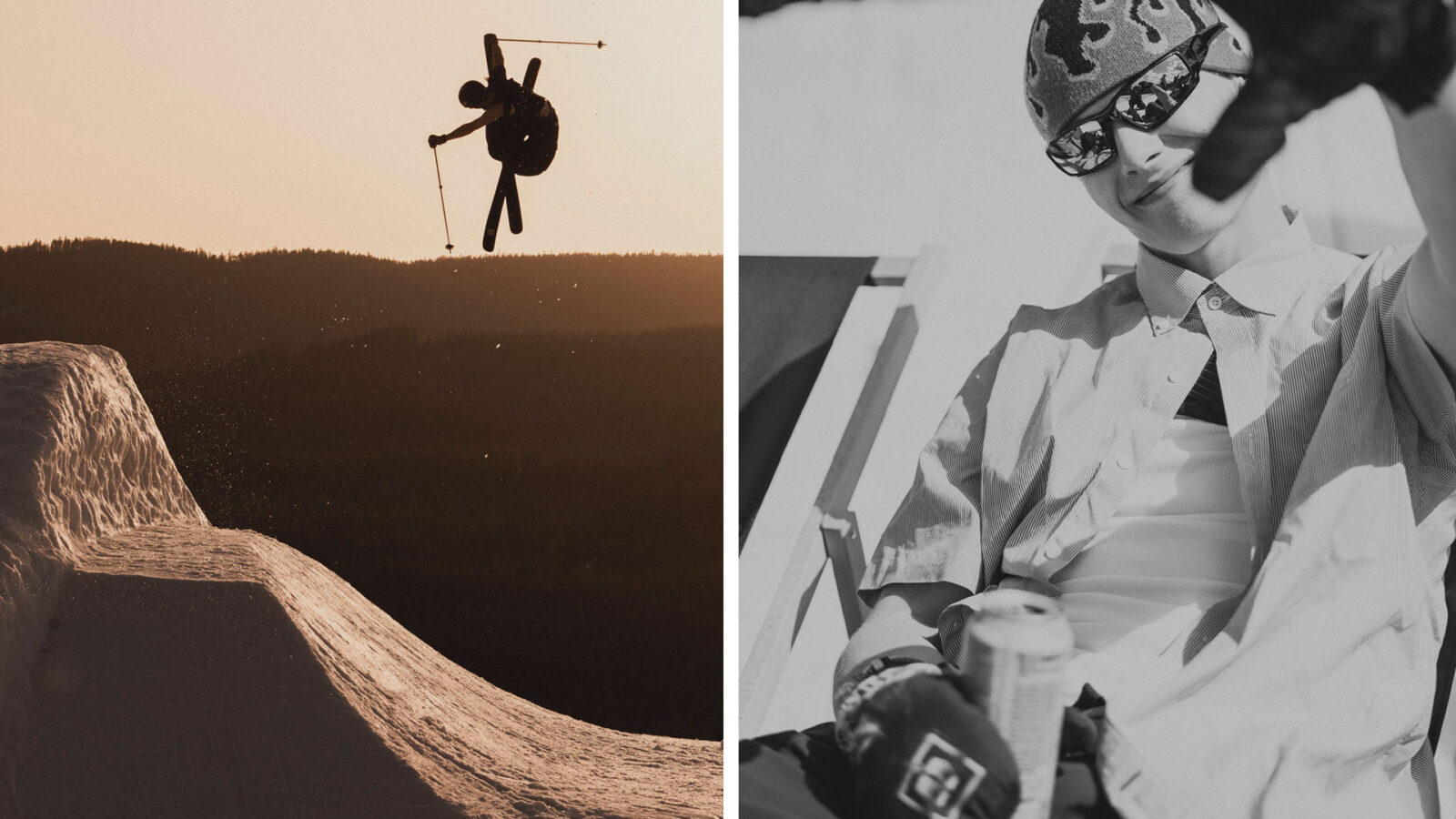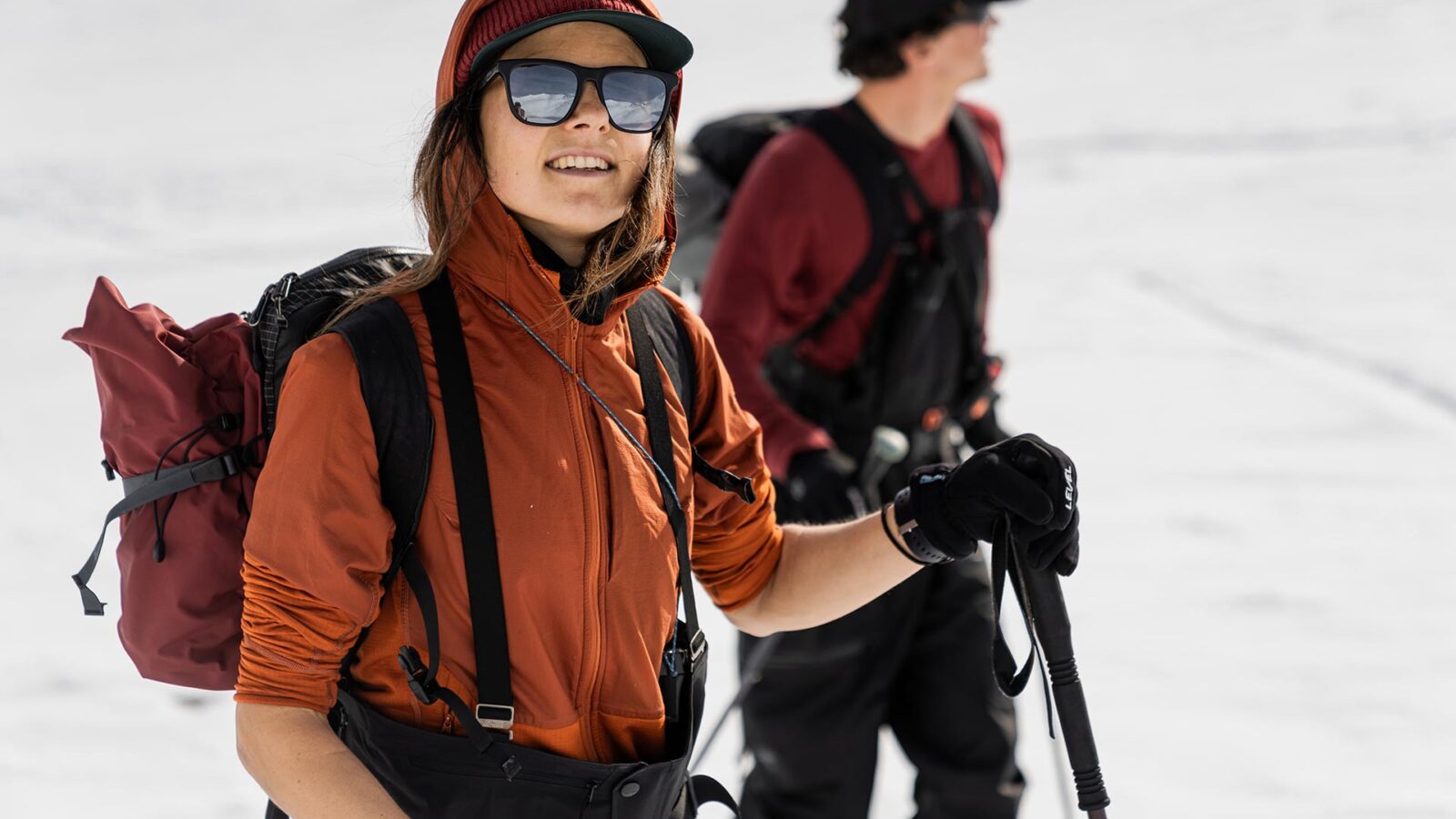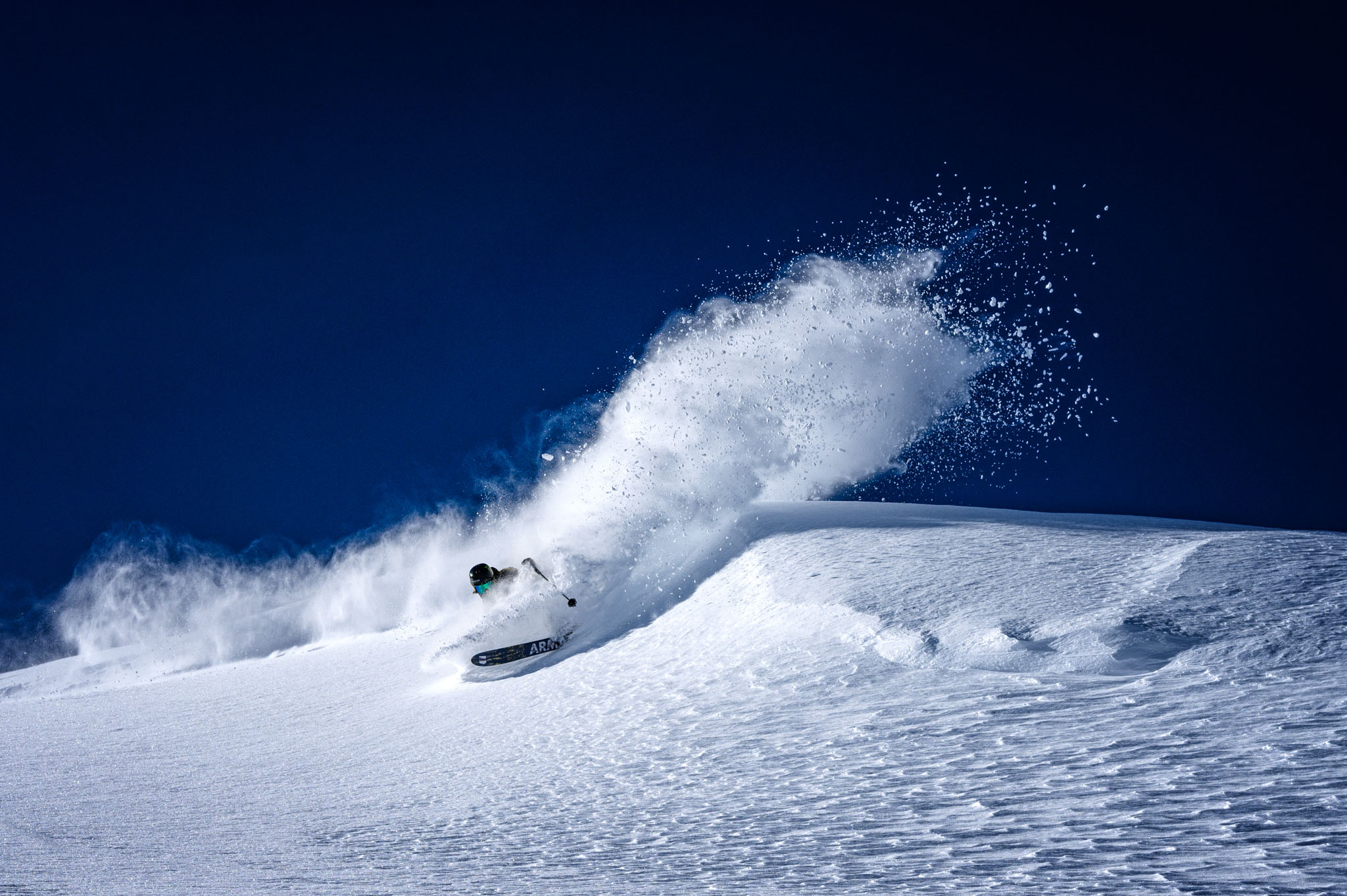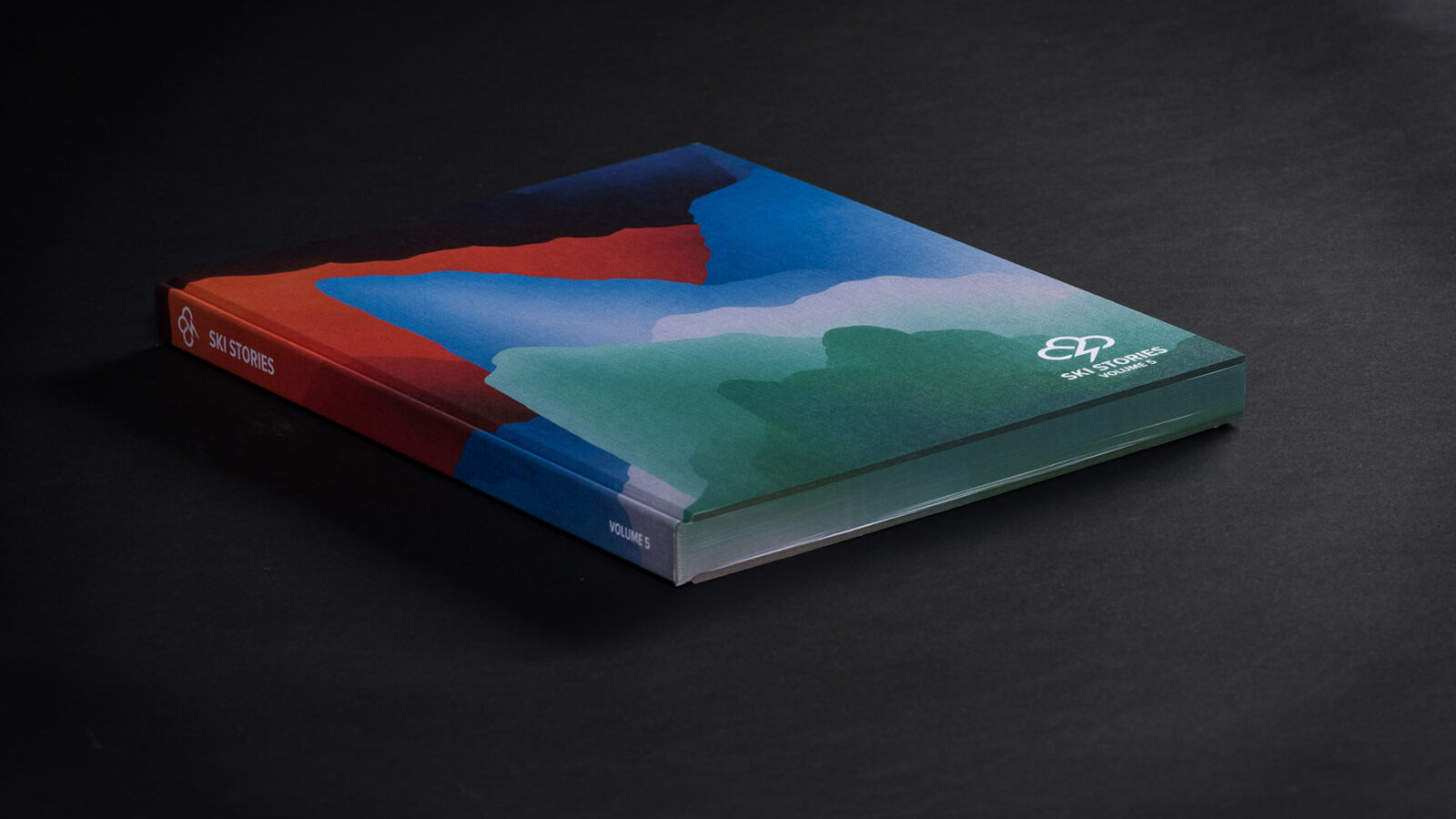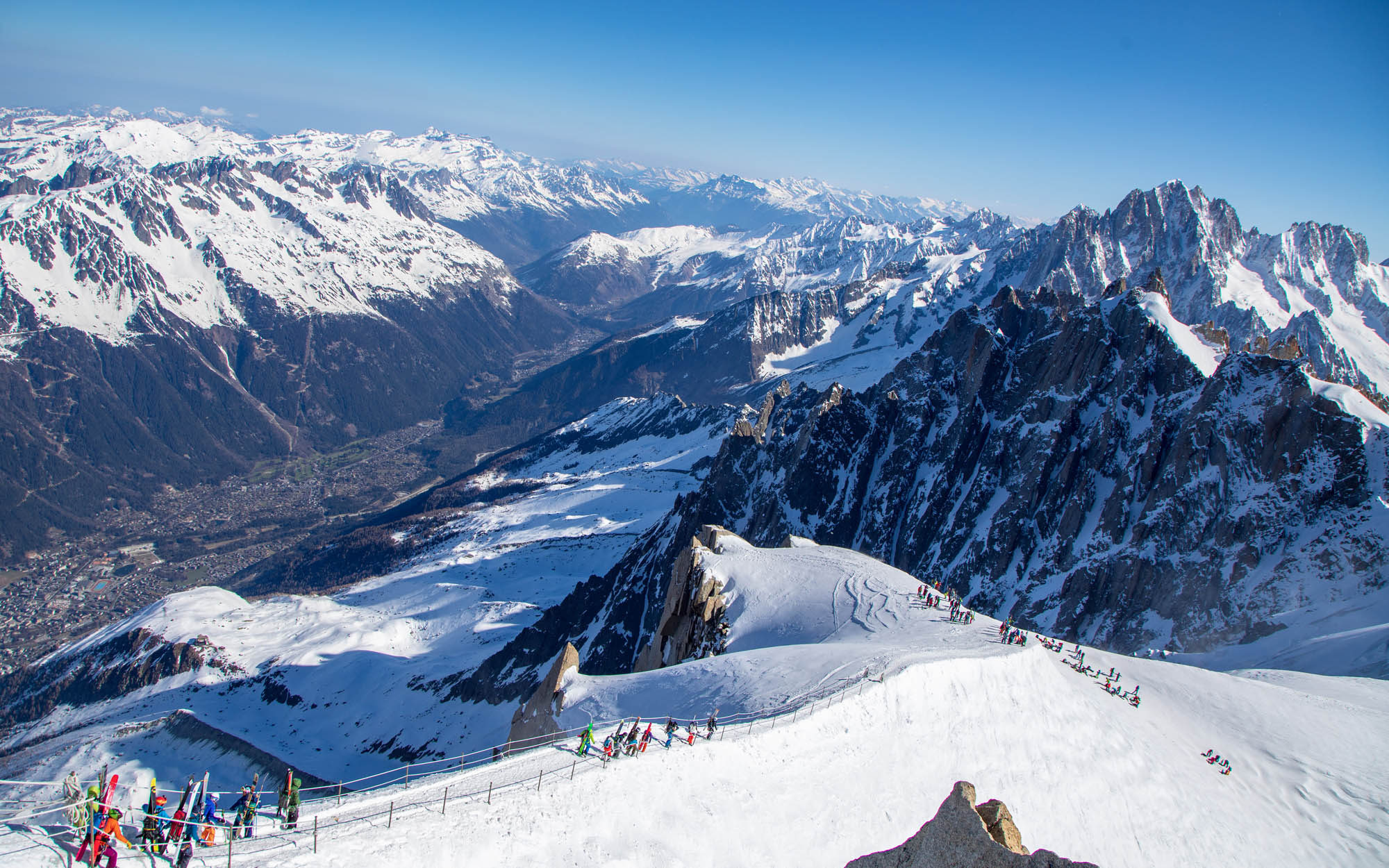
Stories
The Ski Bum’s Guide to Chamonix
Words: Jake Fojtik | Photos: Jake Fojtik & Ethan Stone
Chamonix is a skier’s Mecca: a hallowed, holy proving ground for freeriders, steep skiers and mountaineers alike.
Quick navigation: Accommodations | Getting There | Food & Drink | Grand Montets | Brévent-Flégere | Le Tour | Aiguille du Midi | When to go | Tickets
The resort town is infamous for its gnarly terrain and uber-classic lines off the Aiguille du Midi, as well as the mix of playful and steep terrain pocked through other ski areas in the Chamonix valley. It’s no wonder this place has played home and host to some of the best riders in the world, counting legends such as Andreas Fransson, Sam Favret, Tof Henry, and Leo Slemett among the town’s greats. As a skier or rider, a trip to Chamonix—if not a full season—is a must-have item on your bucket list.
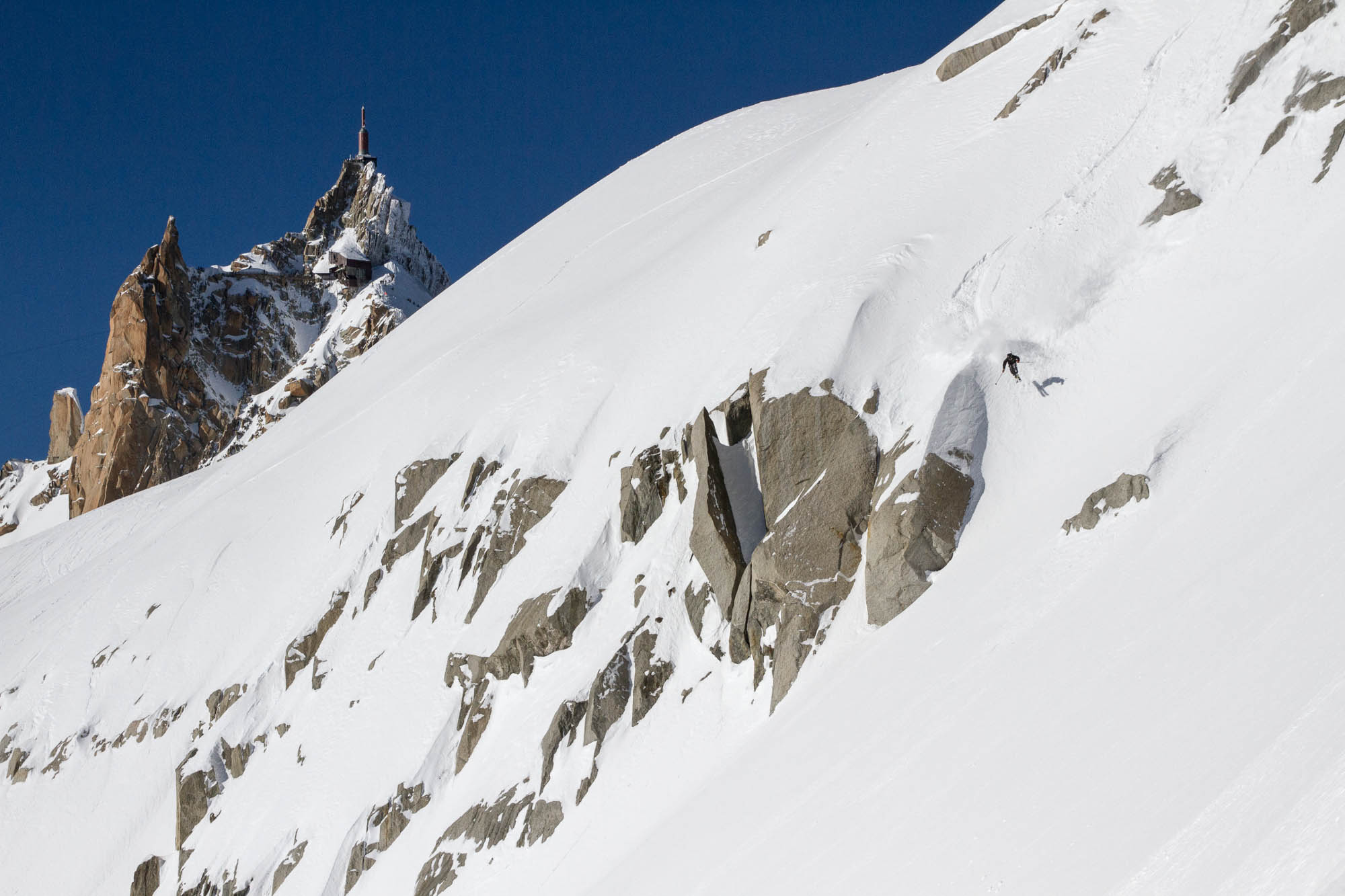
Chamonix is known as the steep skier´s holy grail, but it´s an unmatched gem for freeriders too. Emil Larsen dives in. Photo: Stone
Though at its core Chamonix still courts a strong skier, snowboarder, and climber culture, the picturesque town has long been a destination resort. Hotels, restaurants and bars in town can come with a significant price tag. The Ski Bum’s Guide to Chamonix is here to help you navigate the maze of 5-star hotels and wellness spas to find the best deals and the deepest skiing.
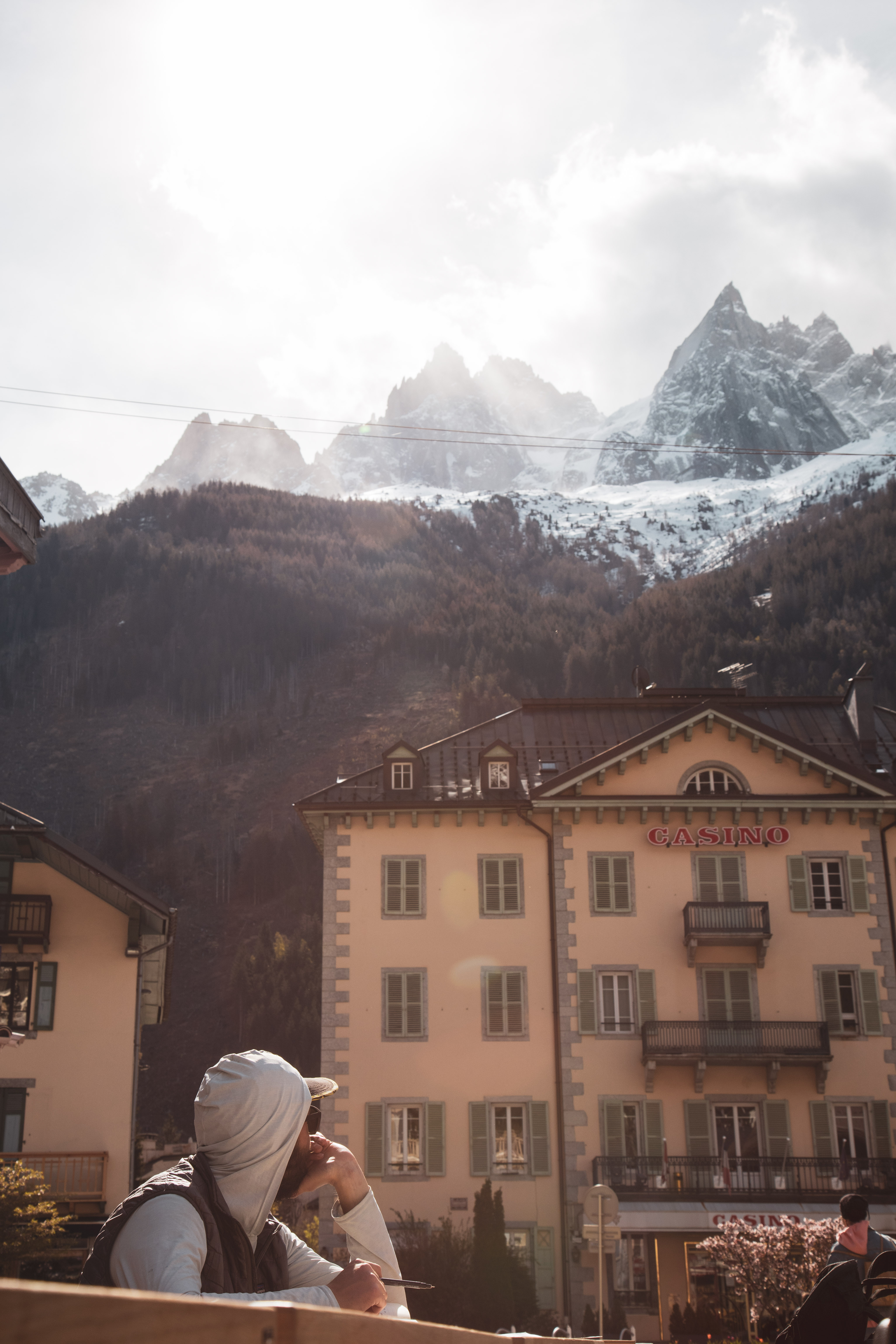
Soaking in Chamonix vibes. Photo: Fojtik
Accommodations
Founded and run by skiers and snowboarders, the Chamonix Lodge specifically caters to the ski bum crowd. Photos of skiers dropping cliffs and spinning off booters line the walls, and ski movies are a staple on the common area TV. Single rooms usually go for €50-60, and single beds in a shared dorm in the €30-40 range, depending on when you book. Found towards the southern side of town, Chamonix Lodge is a 10-minute walk from the Chamonix Sud bus station and 15 minutes from downtown Chamonix and the Aiguille du Midi. Breakfast, coffee, and hot tub access are included. Unless you plan on pitching a tent or score an AirBnB, it’s hard to find cheaper accommodations in town.
Getting there
Europe’s rail network makes Chamonix a (relatively) quick trip from most major cities, making it the easiest way to get to the valley. Flights to Geneva, with an accompanying bus ride up to the town, are the best way to access Chamonix from further away. For those on the east side of the Mont Blanc tunnel, FlixBus runs routes from Turin and Milan that make up to the lack of rail access from the southeast side. Bus is undoubtedly the cheapest way to travel (tickets from Milan to Chamonix can run as low as €7), and budget tickets can be found from nearly every major European city.
Food & Drink
The Chamonix culinary scene lays at the confluence of ski bum and French culture, offering everything from Michelin-starred fine dining and dance clubs to dive bars and hot-dog restaurants. For the ski bum, the Bluebird Cafe offers a rotating specials of various cuisines, everything from enchiladas to thai curry, plus bomber breakfast burritos in a cozy, skier-friendly setting (Black Crows videos are usually shown on repeat). A full hearty dinner usually costs €10 or less.
There’s no better post-skiing meal than a heavy burger and a cold beer, and no better place in downtown Chamonix than Poco Loco to find it. Hefty, delicious go for €7-10 Euros in this cozy, hole-in-the-wall burger joint.
Before, during, or after a night out, top up with a hot-dog from Cool Cats. This isn’t your average American-style hot-dog joint serving plain dogs with ketchup and mustard. Cool Cats serves unique combinations and extravagant toppings, including blue cheese, apple and BBQ sauce, jalapeños and fried eggs, and camembert and fig to name a few, in the €7-12 range. It’s location across from Bar’d Up makes for a great late-night pit stop between bars.
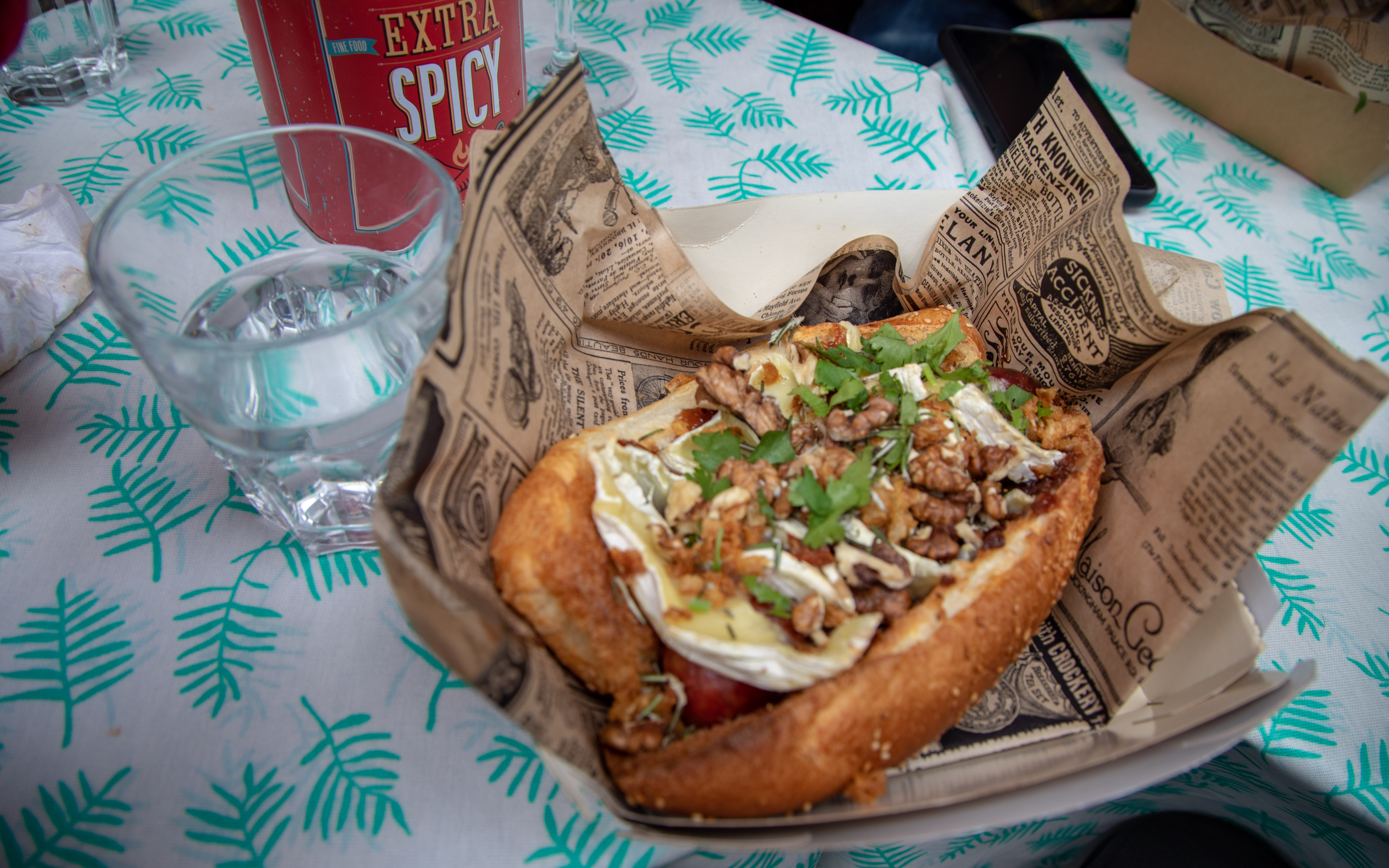
Cool Cats does not serve up your average dogs. Is that brie and walnuts? Photo: Fojtik
A good night out in Chamonix should start with beer, live music, and dancing at Chambre Neuf. Though their pitchers are a bit on the small and expensive side, the tunes, atmosphere, and dancing more than make up for it. Get there early, as bands usually stop playing around 10pm and the bar closes at 11. Watch your toes for people dancing in ski boots.
With its low ceiling, pool tables, darts, and four-hour happy hours, Bar’d Up is one of Chamonix’s best dive bars. Popular with skiers and snowboarders, the drinks are cheap, the staff, and patrons are always friendly (and usually from the UK, Australia, or New Zealand). Monkey serves tacos during the day and reasonably priced drinks at night in a mellow, bar setting. It’s a favorite with the core skier and snowboarder crowd, showing ski movies on all its available screens.
For more intrepid partiers, the raucous Amnesia Night Club and Bunker Club keep the music bumping until 6am. The drinks are much more expensive, however, and a night at these clubs usually means missing the following day of skiing. For a truly eclectic experience, take an evening stumble through the halls of La Folie Douce, a lively hotel complex where you can migrate among floors between upscale bars and an underground club. Just try not to lose too much of your travel budget along the way.
Skiing
With immediate access to world-class resorts, the breathtaking Argentière Basin and the storied spires of the Aiguille du Midi, there’s enough skiing in the Chamonix valley to fill entire guidebooks.
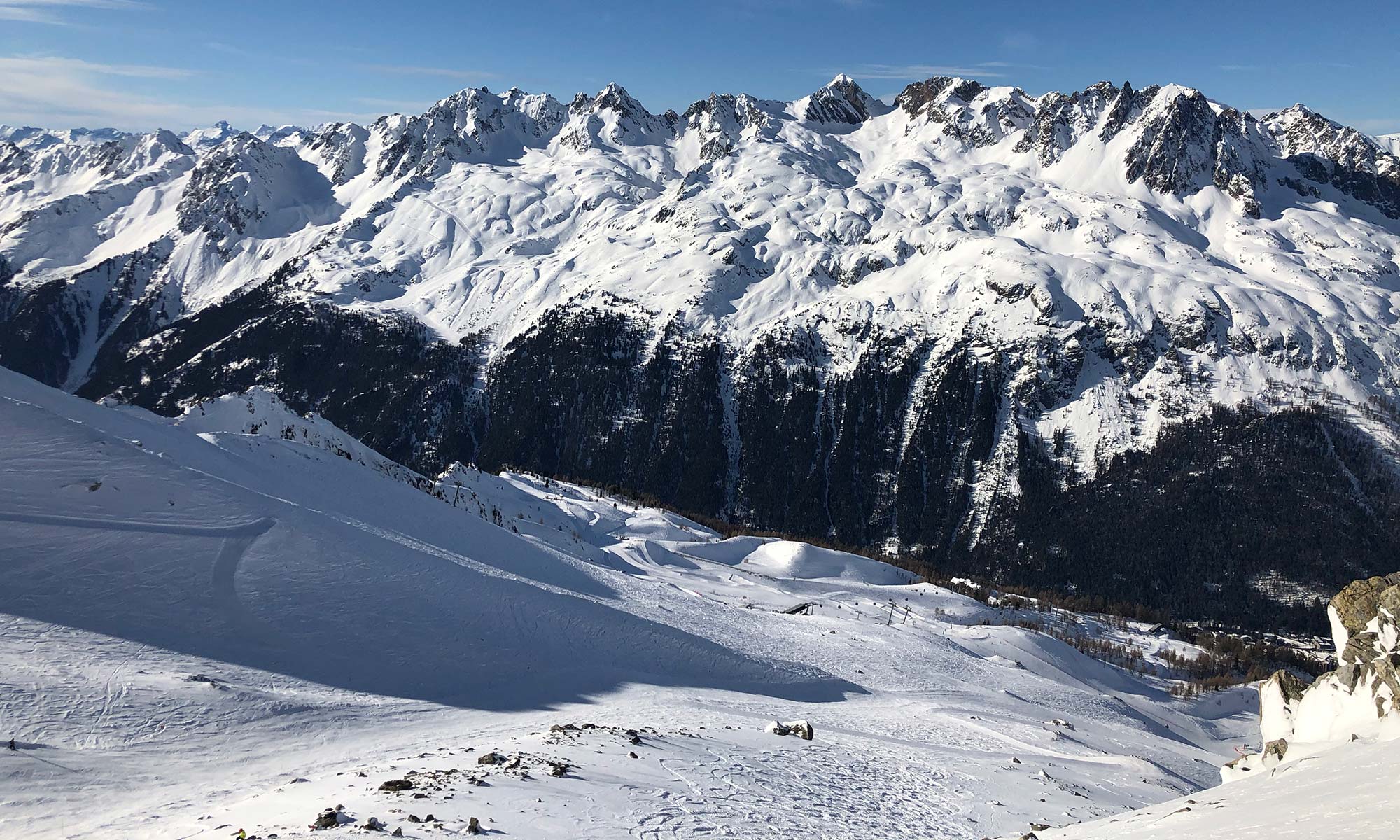
In the foreground, the playful terrain of Grand Montets. In the background, the sprawling slopes of Flégère. Photo: Stone
Grand Montets
Of the “piste” ski resorts in the valley, Grand Montets is the most well known for good reason. The terrain offers open bowls, huckable wind lips and cliffs, steep rocky chutes and tree skiing. If the in-bounds terrain is too tame for you, slap your skins on and head out to the Argentiere basin for some of the steepest, gnarliest terrain in the world.
Though the main gateway to the Argentiere basin, the Grand Montets cable car, burned down in an electrical fire in September 2018, skiers can still access the basin by skinning up from the Bochard cable car or the Herse lift. Steep skiing test pieces like the Couturier Couloir on the Aiguille Verte, the West Couloir on the Aiguille de Chardonnet, and the rarely-skied Col Armand Charlet Northeast Couloir loom tall, proud, and steep in the Argentiere Basin. This is glacial terrain and a much more serious endeavor now that the cable car is gone. For multi-day expeditions, the Argentiere Refuge at 2771 meters is a useful staging point. The hut opens in early March for ski tourers; here you can eat three-course meals and ski classic lines into April and May.
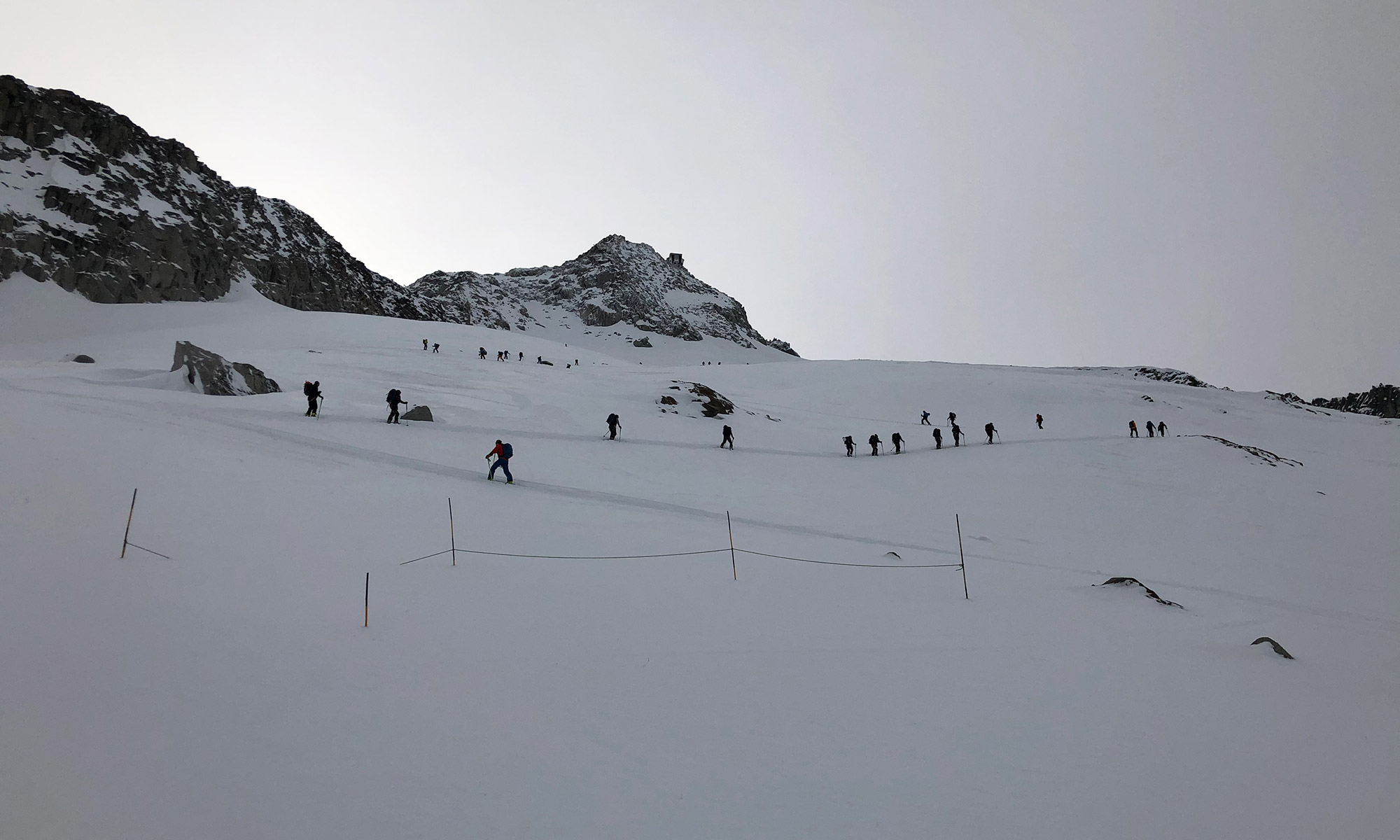
With the Grand Montets cable car out of operation, the Argentiere Basin is now accessible via this popular skin track. Photo: Stone
Ski bum pro tip: bring your own food for Grand Montets, since hut/lodge food prices are in the 15-Euro burger range.
Get there: The resort is a quick ride on the number 1 or 11 bus from the Chamonix Sud bus terminal.
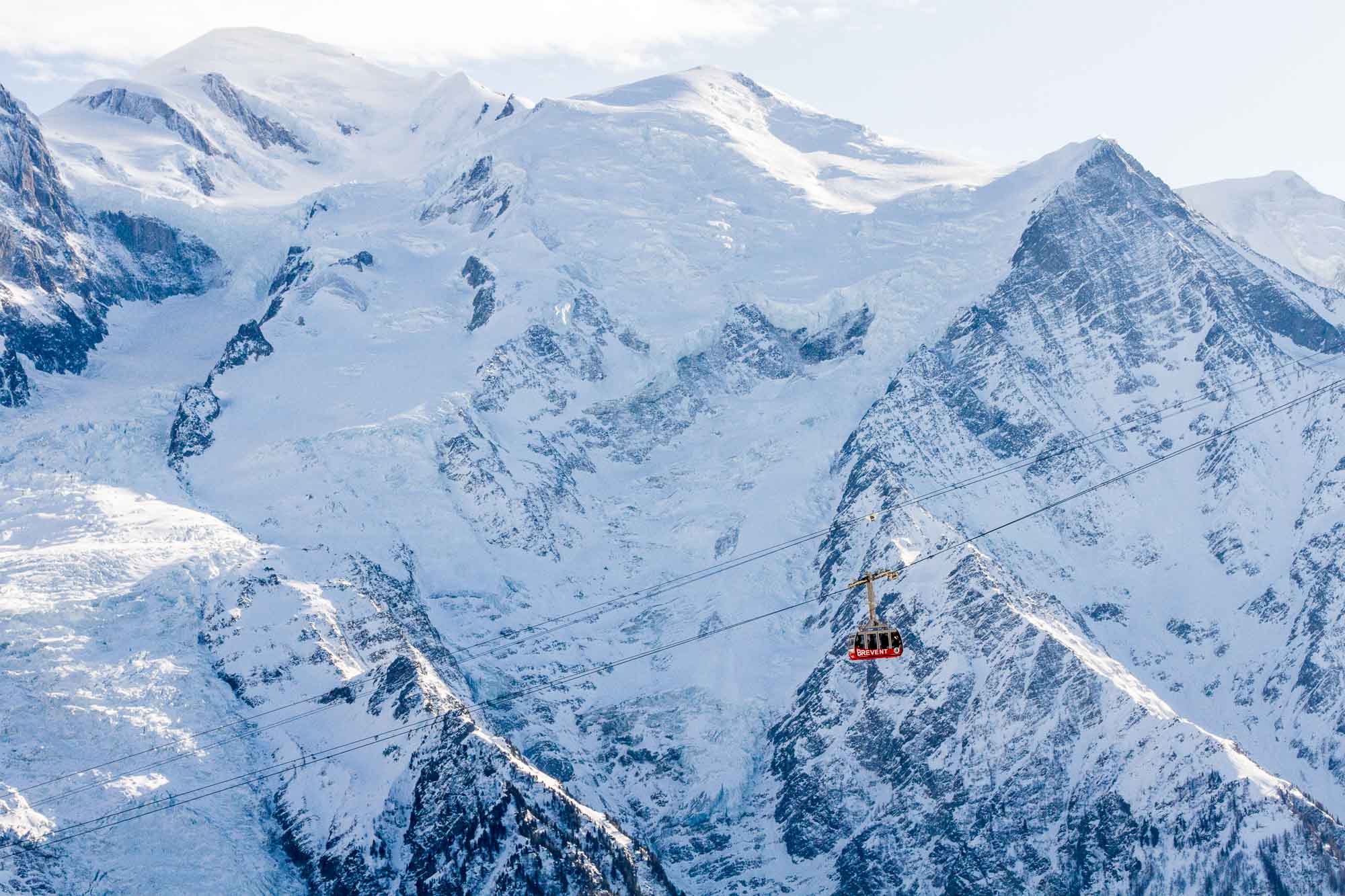
The view from Brévent to the glacial world of Mont Blanc across the valley. Photo: Stone
Brévent-Flégère
Brévent and Flégère are two separate ski areas linked by the Liaison lift. Besides the Aiguille du Midi, Brévent is the closest ski area to town. The Plan Praz cable car rises 1,000 meters from Chamonix to access Brévent, sprawling across the sunny slopes to the northeast of town. Both resorts are a freerider’s haven, and Brévent’s Hotel Face & Aiguille Pourrie have served as venues for the Freeride World Tour.
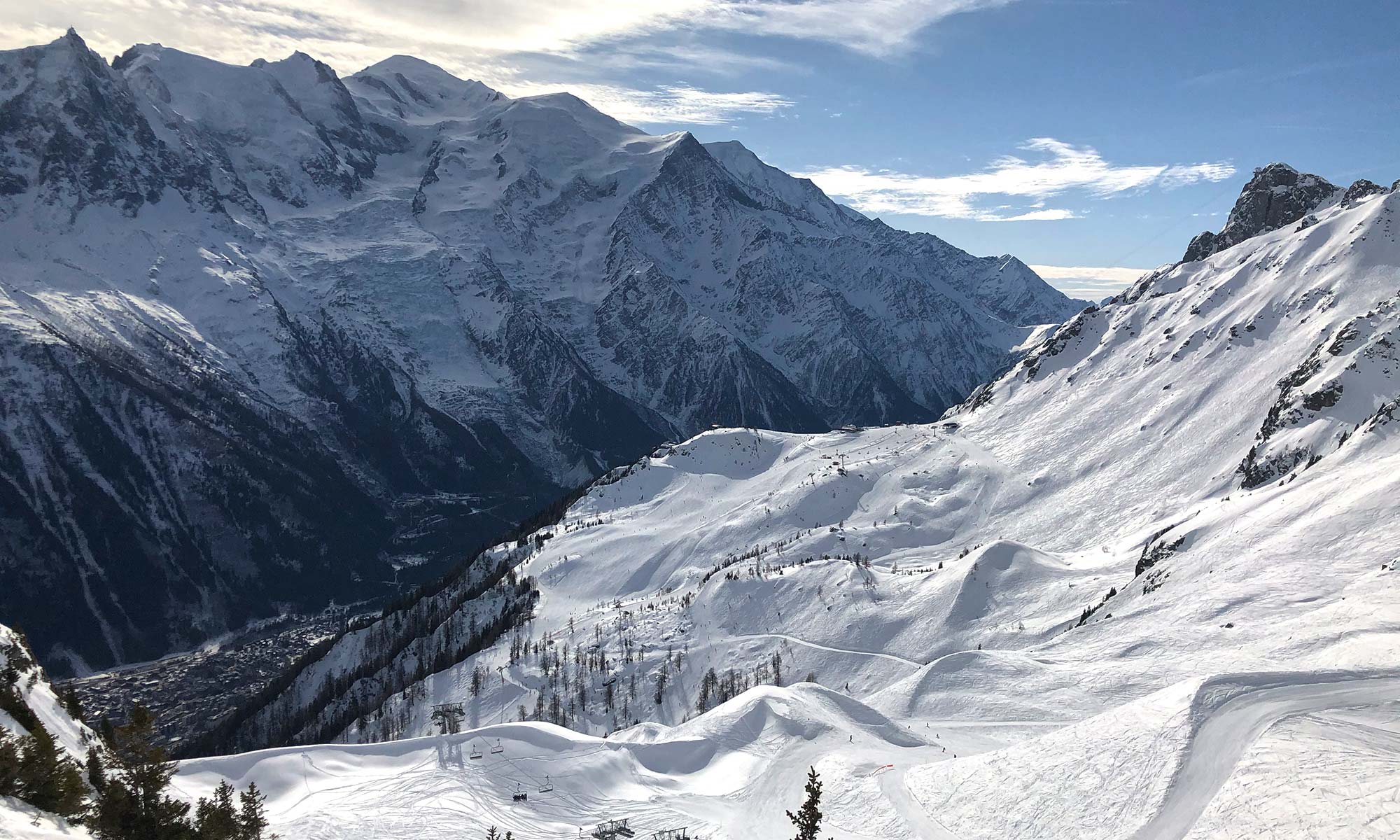
Not ready to ski the Aiguille? No problem, Brévent and Flégère have more than enough terrain to keep you busy. Photo: Stone
Beyond the competition faces, the resorts offer everything from open bowls below the Brévent cable car to steep, rocky chutes next to the Cornu chair. If there’s enough snow, skiers can rip steep trees and chutes from the top of Brévent all the way back to town. However, off-piste skiers should exercise caution: a number of lines cliff out, and avalanche control operations cease beyond the resort borders.
Get there: You can access the Plan Praz cable car from the Chamonix Sud bus station via route 14, or Flégère via the 1 or 2.
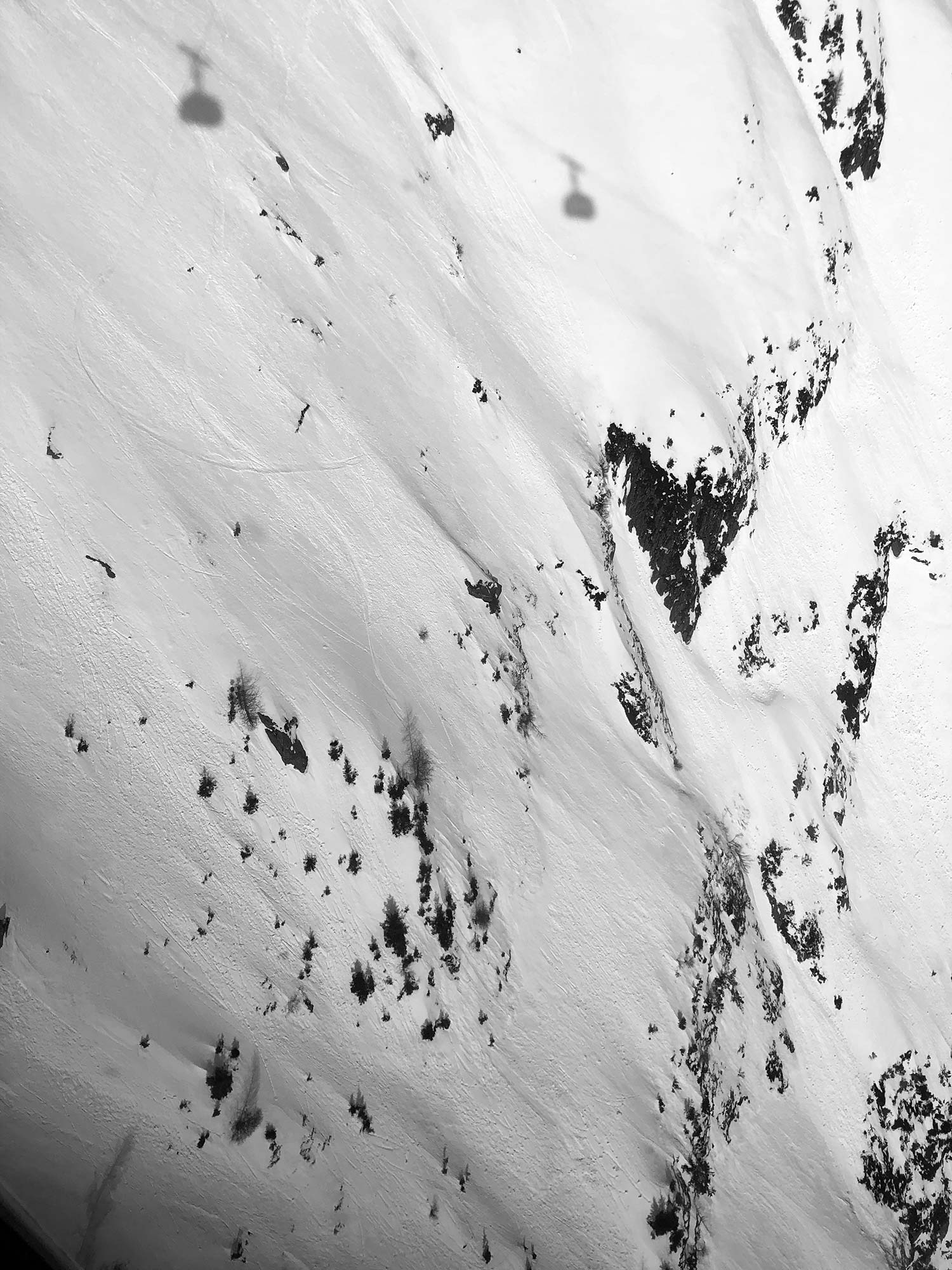
In Chamonix you learn quickly not to follow tracks—like these ones left by speedflyers. Photo: Stone
Le Tour / Vallorcine / Balme
Further from town, Le Tour tends to see less traffic than its counterparts. Most of the resort sits above tree line and the terrain tends to be more open, offering bowls, cliffs, and windlips galore. It’s also a lot less risky and exposed than other places in the valley. It’s hard to get lost there, so it’s a good place send someone there who just wants to ski some powder without things getting complicated. Beneath the cable car, nearly 1000 meters of sustained steep tree skiing separates the resort from the town of Vallorcine.
Get there: Access Le Tour via the 1 or the 12 bus line from Cham Sud.
Last resort: Les Houches
If you really want to ski everything in the valley, check out Les Houches. It’s mostly groomers, but they usually keep a few lifts running even if everything else is closed. If you want to make the most of your pass, it’s worth a try.
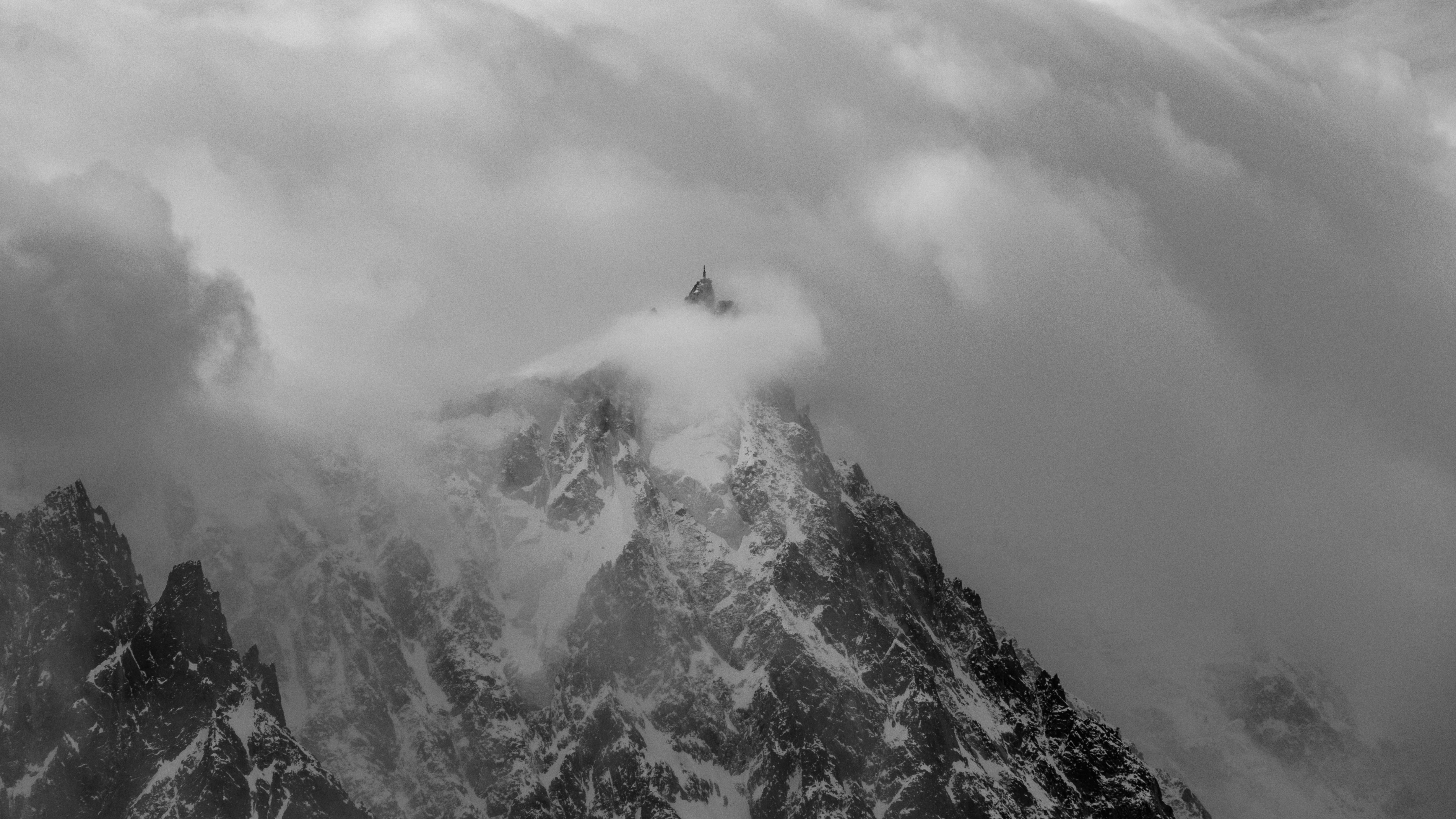
The Aiguille du Midi: a marvel of nature and engineering, gateway to the most accessible steep skiing in the world. Photo: Fojtik
Aiguille du Midi
With access to the Vallée Blanche, Mont Blanc, legendary alpine climbing routes and gnarly ski descents, the Aiguille du Midi needs no introduction. From the top station, riders can tackle the most beautiful and challenging descents on the planet. Surrounded by the piercing peaks of Mont Blanc, Grande Jorrases, and Aiguille Verte, the Vallée Blanche is one of the most spectacular ski runs on the planet. The run skirts the frozen-crystal icefalls of the Mer du Glacé for 12 miles of continuous skiing from the top of Aiguille du Midi back down into town. Skiers looking for more challenging descents can try the Envers routes—like the Grand, Moyen or Petit—which are slightly more challenging variations of the Vallée Blanche, offering the same spectacular scenery on steeper slopes.
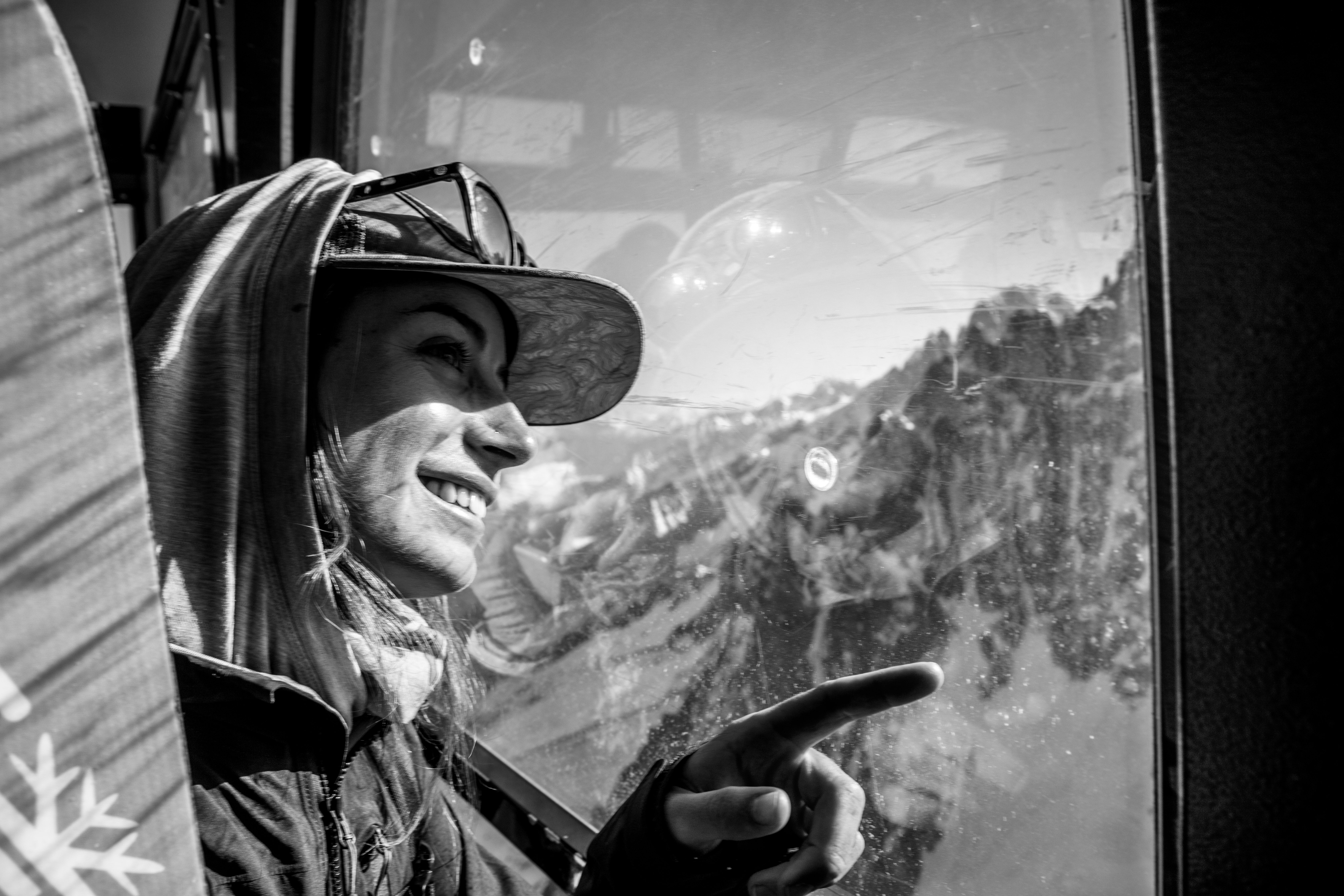
Sophie Fearon scopes what´s left of the Mallory route from the Aiguille du Midi cable car. Photo: Fojtik
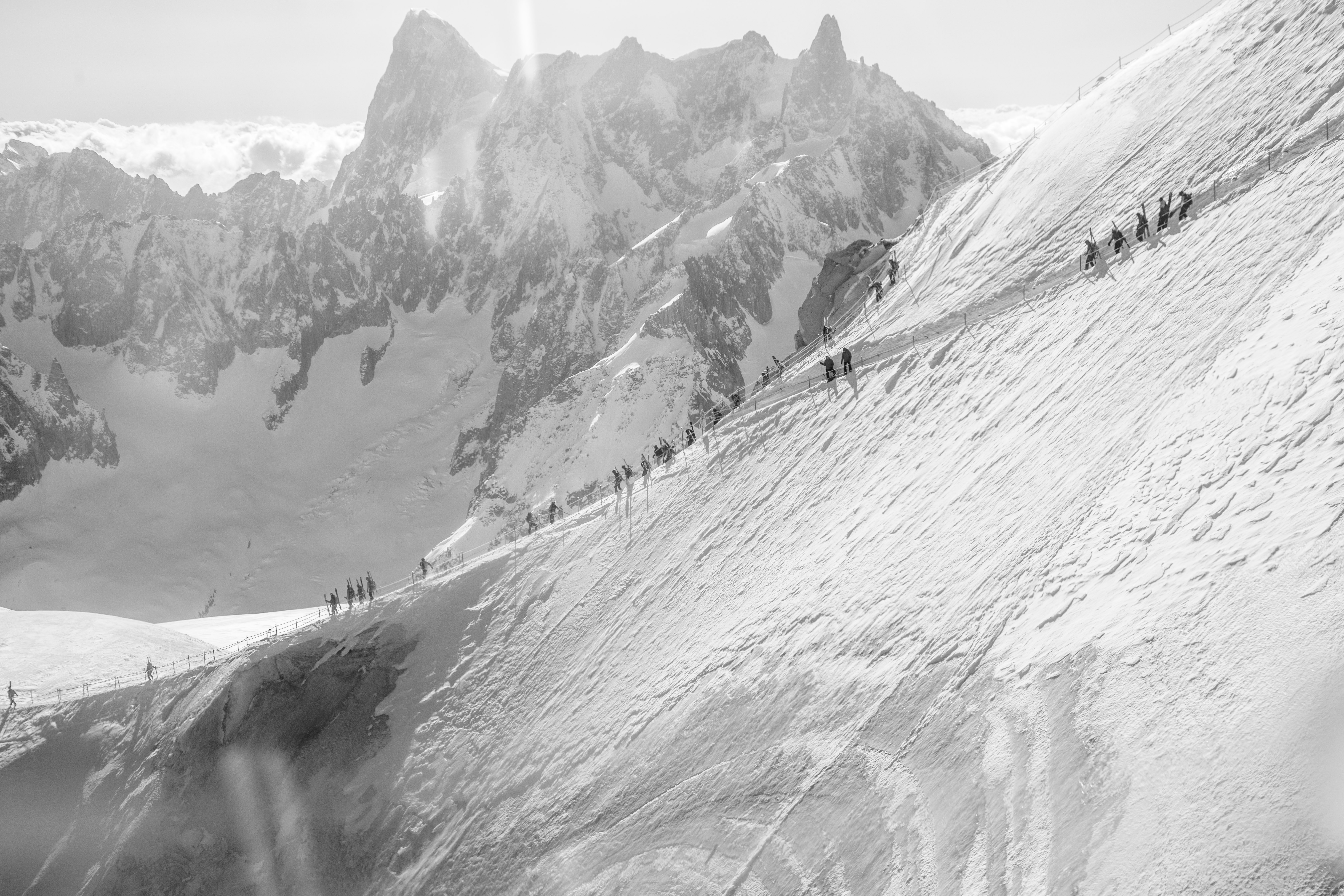
Skiers traversing from the top of the Midi top station to the start of the Vallée Blanche. Photo: Fojtik
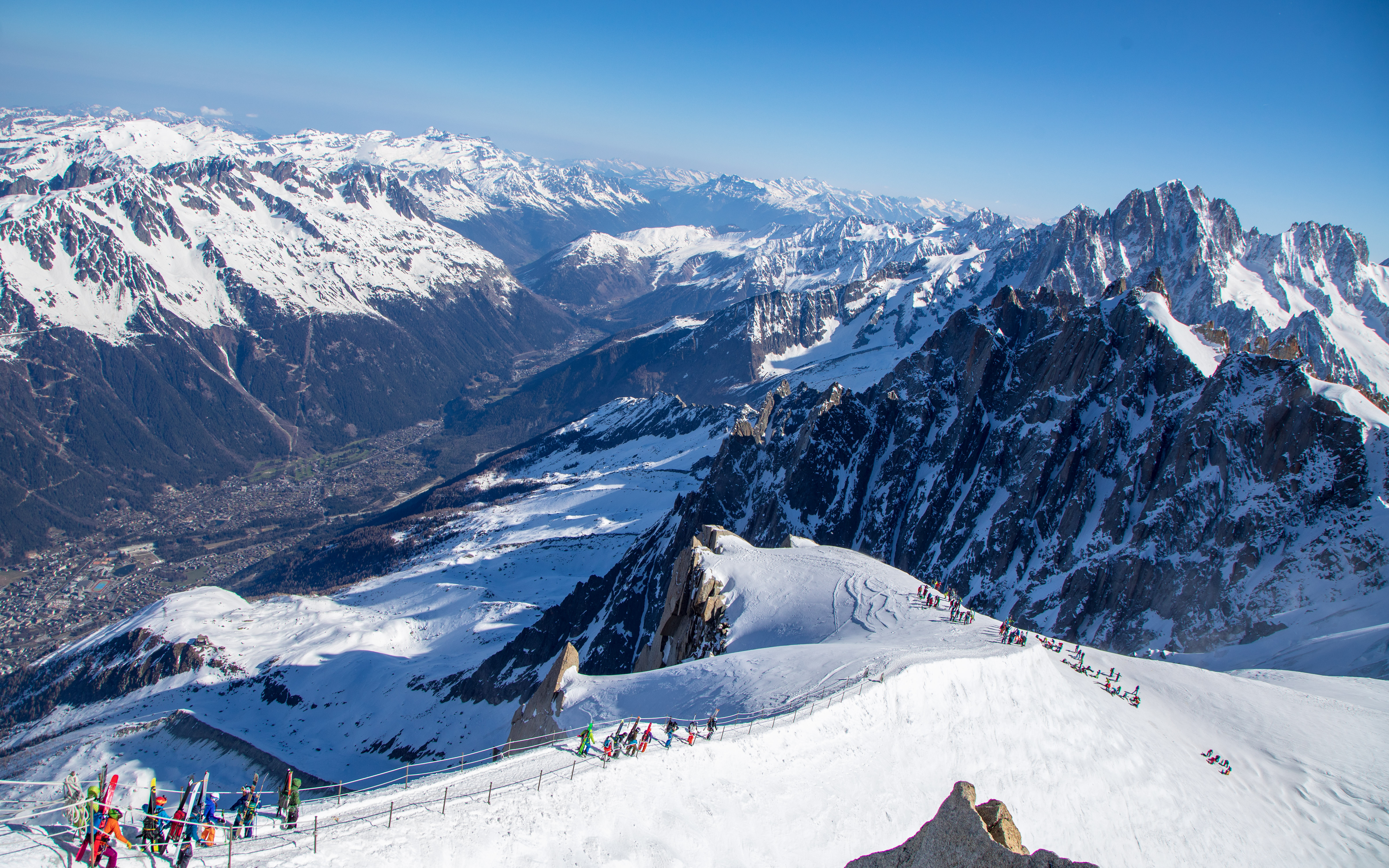
Welcome to the world of the Midi. Photo: Fojtik
Beyond the Vallée Blanche and Envers, the Aiguille du Midi hosts some of the most classic and most feared ski descents in skiing history. Legendary lines such as the Cosmiques couloir, the Mallory, the Gervasutti, the Pain du Sucre, the Spencer and the Col du Plan dot the surrounding ridgelines. These routes are among the steepest and most difficult lines in the world; do not approach them lightly, as consequences can be fatal.
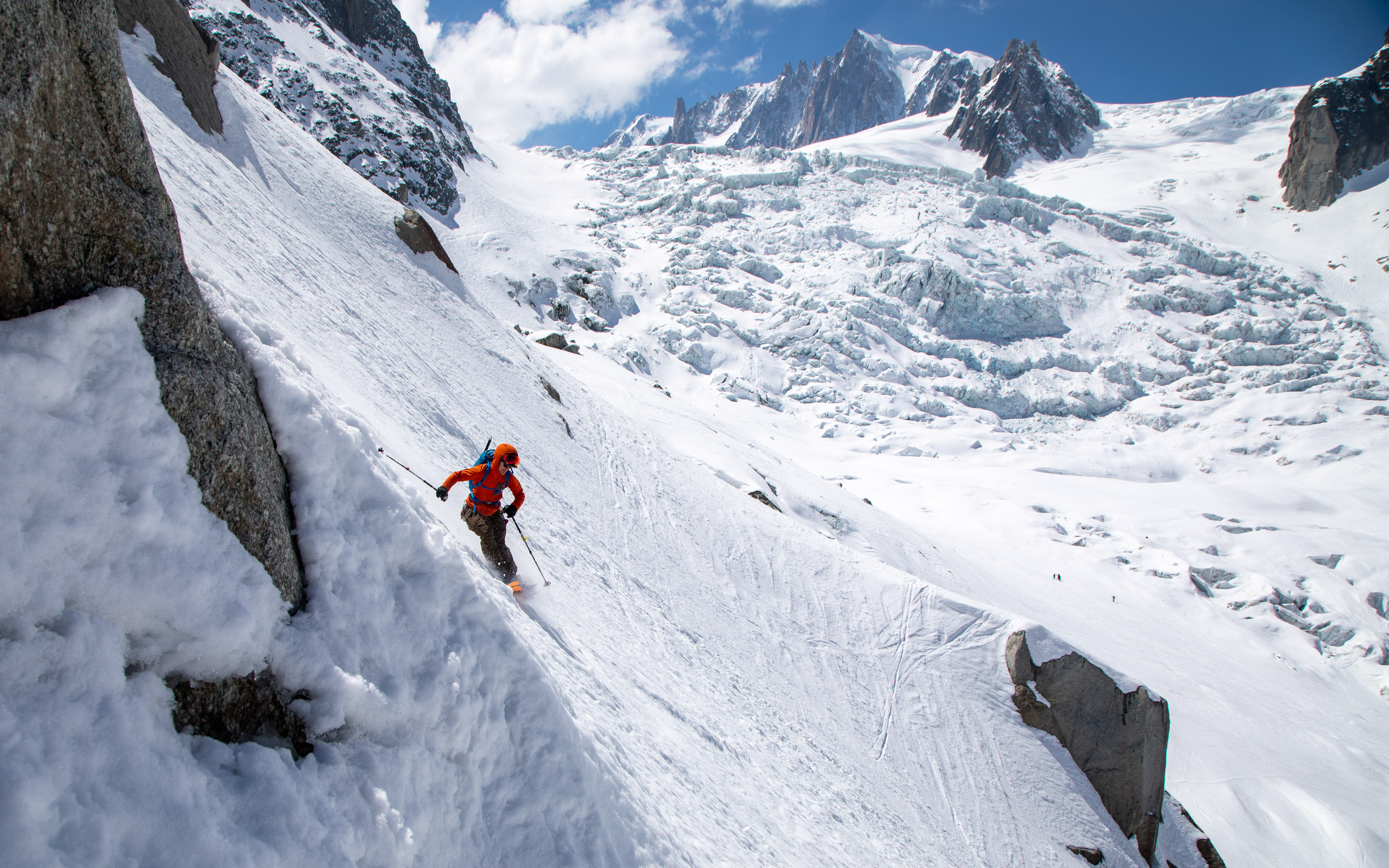
Max Ritter explores a variation of the Vallée Blanche route. Photo: Fojtik
Simply put, the Aiguille du Midi cable car offers lift service to some of the most extreme ski terrain in the world, almost none of which should be attempted by the casual visitor. It’s not mandatory to hire a guide to ski the Vallée Blanche, but you shouldn’t go it alone unless you’ve got extensive experience in glacial terrain. You’ll also need a harness, rope and the associated gear (carabiners, slings, ice screws, pulleys etc.) to perform a crevasse rescue, and know how to do one. If you’re not absolutely solid on any of this, do yourself a favor and hire a guide—they run upwards of €350 for a group of four.
When to go
If you’re looking to ski powder and taste some of the potential of Chamonix’s freeride terrain, anytime from January to mid-March will do just fine. If you’re looking to dabble in some of the valley’s vaunted steep skiing, you might be well served by coming in the season—most of the big lines aren’t in condition until April. The end of March until mid-May is the time frame for anything that hot-shots in the valley consider “steep skiing”—lines of steep glacial ice that need wet spring snow to plaster their walls.
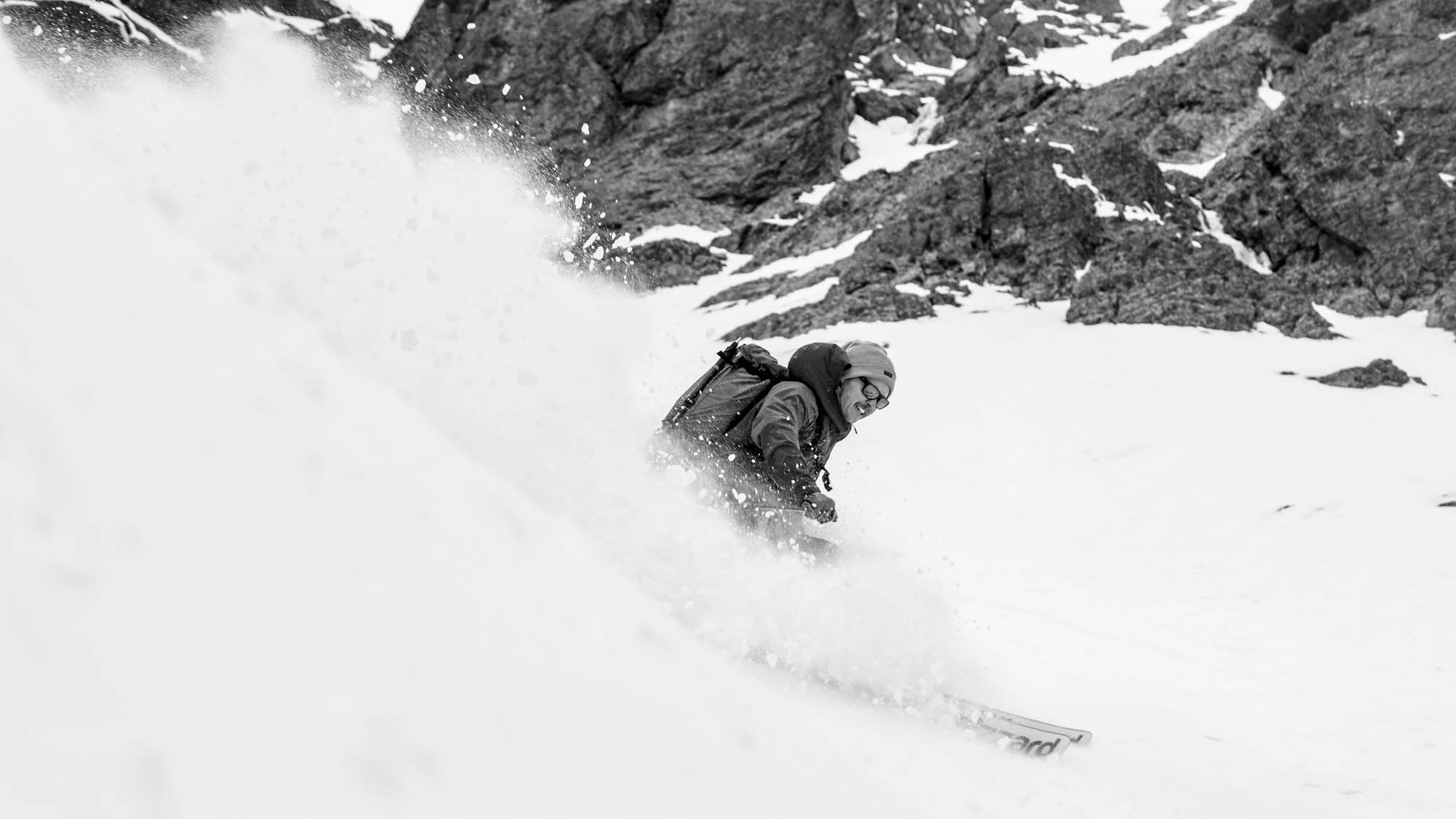
Scoring April pow turns. Photo: Fojtik
Tickets
The lift ticket system in Chamonix can be a bit confusing. The Mont Blanc Unlimited pass (€67 for a one-day pass) covers all the lifts in the valley including the Aiguille du Midi. A 2-day pass or longer also gets you access to the nearby resorts of St. Gervais and Megève, as well as Courmayeur on the Italian side of the Mont Blanc tunnel and its Skyway tram (another freeriders’ crown jewel). Six-day and longer Unlimited passes also include access to nearby Verbier - 4 Vallées in Switzerland.
If the Unlimited pass sounds a bit decadent, the more affordable option is Le Pass (€55 for a one-day pass), which covers the three main ski resorts in the Chamonix valley: Brevént-Flégère, Grand Montets and Balme-Le Tour-Vallorcine. There’s also a four-hour option available for €48.50. You can easily have the time of your life in Chamonix skiing on Le Pass. Just keep some money on the side if you want to pay for an extra pilgrimage up the Aiguille du Midi.

